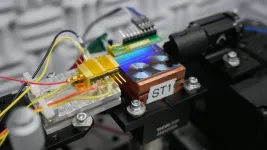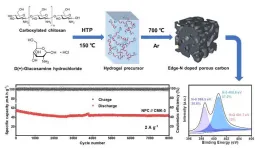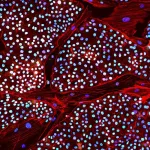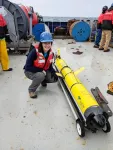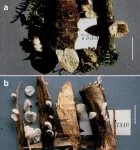(Press-News.org) One of the fundamental goals of basic biology is understanding how diverse cell types work in concert to form tissues, organs, and organ systems. Recent efforts to catalog the different cell types in every tissue in our bodies are a step in the right direction, but only one piece of the puzzle. The great mystery of how those cells communicate with one another remains unsolved.
Now, a new paper in Nature describes uLIPSTIC, a tool capable of laying the groundwork for a dynamic map tracking the physical interactions between different cells—the elusive cellular interactome. The authors have been perfecting the technology since 2018 and the latest iteration can in principle allow researchers to directly observe any cell-to-cell interaction in vivo.
"With uLIPSTIC we can ask how cells work together, how they communicate, and what messages they transfer," says Rockefeller's Gabriel D. Victora. "That's where biology resides."
Kiss-and-run
Ever since single-cell mRNA sequencing came into its own, researchers have been scrambling to connect the dots and explain how diverse cells unite to form tissue. Several methods of cataloging cell-to-cell interactions have already emerged, but all have considerable shortcomings. Early efforts that involved direct observation under a microscope failed to retrieve interacting cells for further analysis; subsequent attempts leaned on advanced imaging techniques that intuit how cells might interact based on their structure and proximity to other cells. No approach captured true physical interactions and signal exchange between cell membranes.
Enter LIPSTIC, an innovative approach from the Victora lab that involved labeling cellular structures that touch when two cells make fleeting, "kiss-and-run" contact before parting ways. The labels ensured that, if one cell "kissed" another, it would leave a mark akin to a lipstick, enabling easy identification and quantification of physical interactions between cells.
Originally, the platform had narrow applications. Victora and colleagues designed LIPSTIC to record a very specific kind of cell-to-cell interaction between T cells and B cells, a major focus of their lab. Other researchers, however, began clamoring for a version of LIPSTIC that would work on other cellular interactions too. "We could have tailored a LIPSTIC for every type of interaction," Victora says. "But why not try to make a universal version, instead?"
Mapping every interaction
In the original version of LIPSTIC, a “donor” cell uses an enzyme borrowed from bacteria to place a labeled peptide tag onto the surface of an “acceptor” cell upon contact—the biochemical equivalent of applying lipstick to one cell and looking for a kiss print on another. That method required knowing exactly how the "kiss" would occur, identifying molecules the donor cell uses to interact with recipient cells and painstakingly forcing the tags onto those molecules. But over time the team discovered that dousing the cells with a high volume of enzyme and its target would ensure that any interaction that one cell had with another cell would be tracked just as efficiently.
"If you cram partner cells with enough enzyme and target, you can make any any cell pair capable of LISPTIC labeling without needing to know in advance what molecules these cells will use for their interaction," Victora says.
The result was a uLIPSTIC, a universal platform not bound by foreknowledge of molecules, ligands, or receptors. Scientists can now theoretically smear uLIPSTIC on any cell, without preconceived notions of how it would interact with its environment, and observe physical cell-to-cell interactions. To demonstrate the power of the platform, the team showed that uLIPSTIC could expand beyond LIPSTIC's narrow repertoire of B cells and T cells to track how dendritic cells kickstart the body's immune response against tumors and food allergens.
"The reception to uLIPSTIC has been great," says Sandra Nakandakari-Higa, a PhD student in the Victora lab and lead author on the paper. "We’re already getting a lot of inquiries from other labs about how they can adapt our system to their models."
The team hopes to eventually use uLIPSTIC to discover the receptor-ligand pairs key to cellular interactions, in an effort to better understand how cells unite into tissue at the molecular level. Eventually, the team envisions uLIPSTIC as a key tool in the effort to generate comprehensive atlases describing how cells interact to form tissue—a key to the long-awaited interactome.
END
Universal tool for tracking cell-to-cell interactions
2024-03-06
ELSE PRESS RELEASES FROM THIS DATE:
Synthetic DNA sheds light on mysterious difference between living cells at different points in evolution
2024-03-06
“Random DNA” is naturally active in the one-celled fungi yeast, while such DNA is turned off as its natural state in mammalian cells, despite their having a common ancestor a billion years ago and the same basic molecular machinery, a new study finds.
The new finding revolves around the process by which DNA genetic instructions are converted first into a related material called RNA and then into proteins that make up the body’s structures and signals. In yeast, mice, and humans, the first step in a gene’s expression, transcription, proceeds as DNA molecular “letters” (nucleobases) are read in one direction. While 80% of the human genome ...
AI can speed design of health software
2024-03-06
Artificial intelligence helped clinicians to accelerate the design of diabetes prevention software, a new study finds.
Publishing online March 6 in the Journal of Medical Internet Research, the study examined the capabilities of a form of artificial intelligence (AI) called generative AI or GenAI, which predicts likely options for the next word in any sentence based on how billions of people used words in context on the internet. A side effect of this next-word prediction is that the generative AI “chatbots” like chatGPT can generate replies to questions in realistic language, and produce clear summaries of complex texts.
Led ...
Shrinking technology, expanding horizons
2024-03-06
The National Institute of Standards and Technology (NIST) and its collaborators have delivered a small but mighty advancement in timing technology: compact chips that seamlessly convert light into microwaves. This chip could improve GPS, the quality of phone and internet connections, the accuracy of radar and sensing systems, and other technologies that rely on high-precision timing and communication.
This technology reduces something known as timing jitter, which is small, random changes in the timing of microwave signals. Similar to when a musician is trying to keep a steady beat in music, the timing of these signals can sometimes waver a bit. The researchers ...
Edge-nitrogen doped porous carbon for energy-storage potassium-ion hybrid capacitors
2024-03-06
They published their work on March. 4th in Energy Material Advances, a Science Partner Journal (https://spj.science.org/journal/energymatadv).
"The development of cost-effective and high-performance electrochemical energy storage devices is imperative," said paper's corresponding author Wei Chen, a professor in the School of Chemistry and Materials Science, University of Science and Technology of China (USTC). "Currently, lithium-ion batteries still dominate the market, but they are limited in both lithium as a resource and in their power densities."
Chen ...
Revolutionary elephant iPSC milestone reached in Colossal’s Woolly Mammoth Project
2024-03-06
Dallas, TX – March 06, 2024 - Colossal Biosciences (“Colossal”), the world’s first de-extinction company, announces today that their Woolly Mammoth team has achieved a global-first iPSC (induced pluripotent stem cells) breakthrough. This milestone advancement was one of the primary early goals of the mammoth project, and supports the feasibility of future multiplex ex utero mammoth gestation.
iPSC cells represent a single cell source that can propagate indefinitely and give rise to every other type of cell in a body. As such, the progress with elephant iPSCs extends far beyond ...
JAMA study finds facilities treating poor patients penalized by CMS payment model
2024-03-06
INDIANAPOLIS – A new study of more than 2,000 dialysis facilities randomized to a new Medicare payment model aimed to improve outcomes for patients with end-stage kidney disease has found that facilities that disproportionately serve populations with high social risk have lower use of home dialysis and transplant waitlisting and fewer kidney transplants. These facilities thus received reduced performance scores and reimbursement from Medicare.
A high proportion of non-Hispanic Blacks and of those initiating dialysis while uninsured or Medicaid-covered also was found to be an indicator of lower use of home dialysis and transplant waitlisting and fewer kidney ...
For Boston College professor, research into "high latitude" reaches of the seas led to improving accurate access to real-time ocean data
2024-03-06
Chestnut Hill, Mass (03/06/2024) – Boston College Assistant Professor of Earth and Environmental Sciences Hilary Palevsky has been awarded a nearly $1-million National Science Foundation CAREER Award for her work to make remote ocean monitoring data accessible and accurate in real time and produce a series of educational videos to guide students using the data.
Palevsky, whose research focuses on marine biogeochemistry and the mechanisms that enable the ocean to absorb carbon dioxide from the atmosphere, said the funding will allow her to build upon the work she has done to help scientists use the ...
Microbes impact coral bleaching susceptibility, new study shows
2024-03-06
Washington, D.C. – March 6, 2024 – A new study provides insights into the role of microbes and their interaction as drivers of interspecific differences in coral thermal bleaching. The study was published this week in Applied and Environmental Microbiology, a journal of the American Society for Microbiology.
“The diversity, community dynamic and interaction of coral associated microorganisms play important roles in the health state and climate change response pattern of coral reefs,” said lead study author Biao ...
Study: Black boys are less likely to be identified for special education when matched with Black teachers
2024-03-06
WASHINGTON, March 6, 2024—Black male elementary school students matched to Black teachers are less likely to be identified for special education services, according to new research published today. The relationship is strongest for economically disadvantaged students. The study, by Cassandra Hart at the University of California, Davis, and Constance Lindsay at the University of North Carolina at Chapel Hill appeared in the American Educational Research Journal, a peer-reviewed journal of the American Educational Research Association.
The researchers also found that the connection is ...
A new genus of fungi on grasses
2024-03-06
While ecologically important, small mushrooms on monocots (grasses and sedges) are rarely studied and a lack of information about their habitat and DNA sequences creates difficulties in determining their presence or absence in ecological studies and their genetic relationships to other mushroom taxa.
This study led by Drs. Karen W. Hughes and Ronald H. Petersen (University of Tennessee, Knoxville, TN, USA) examined a mushroom species, Campanella subdendrophora, (also known as Tetrapyrgos subdendrophora), which fruits on grasses in the US Pacific Northwest.
The researchers evaluated its phylogenetic position concerning both Campanella and Tetrapyrgos ...
